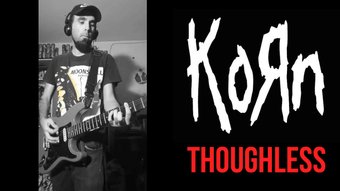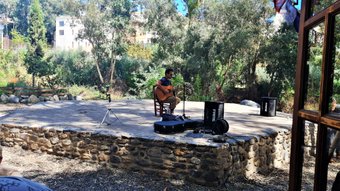¿Conoces el Orden de los Sotenidos y de los Bemoles?. Ven y entérate un poco. by nazatpt
9
About :

El orden de los sostenidos y bemoles es una estructura necesaria para el desarrollo de una partitura. Específica ordenadamente la estructura de la escala y es parte de la armadura de clave.
!
Editado - Canva Editor
Edición de vídeo - Capcut Editor
Hablemos un poco de teoría musical. Antes de seguir escribiendo, quiero dejar en claro que no soy el mejor en teoría, pero con lo poco que sé, quiero transmitirlo aquí en la blockchain, si puede llegar a alguno de ustedes y brindarle algo de conocimiento, esa es la idea principal de éste vídeo.
Ya que di mi introducción comencemos, el orden de sostenidos y bemoles. Sé que quizás muchos de nosotros no hayamos estado muy enterados de toda la teoría musical, eso no tiene nada de malo. Tengo amigos que son excelentes músicos pero su interés por la teoría es casi escaso. ¿Por qué?, porque en realidad no la necesitan.
Por ejemplo tengo dos amigos que por respeto a sus privacidad les llamaré Paco y Brandon, Paco toca guitarra, bajo eléctrico, guitarrón, piano y es un excelente cantante. Brandon igualmente toca guitarra, guitarrón y bajo, además sabe algo de mandolina y le va muy bien con la vihuela y el cuatro venezolano.
Ambos muy buenos músicos, la historia va porque un día me sorprendió escuchar que tenían interés de saber leer partituras. Llegué a cuestionarme, dos excelentísimos músicos no tenían nada de conocimiento referente a esto. La explicación es que tocan instrumentos armónicos. Aparte de eso son muy buenos en música popular. La académica es otro universo.
Entonces me dije, ¿Cuántos excelentes músicos dentro de la blockchain no tendrán conocimientos de ciertas cosas?. Y heme aquí, ésta es una participación personal en la cual trataré, enserio trataré de hacer semanalmente un vídeo. Referente a teoría musical y uno que otro tema de interés. Espero sea bien recibida mi participación en ésta nuestra comunidad de #music.
Muy bien, empecemos. ¿Por qué existe el orden de sostenidos y bemoles?. Existe como una opción de simplificar los sonidos de una manera en que matemáticamente el ser humano pueda calcular fácilmente. De ésta forma el circulo de quintas que es de donde se desprende éste orden hace función en un sistema tonal.
Excluyendo el tono de Do mayor porque es la única escala sin alteraciones además de sus parecidas en el sistema modal. Partimos desde un SolM a la cual contaremos cinco grados por encima y nos dará un ReM, a la cual contaremos cinco grados por encima y nos dará un LaM. Si nos damos cuenta, Sol mayor tiene una sola alteración (fa#), re mayor cuenta con dos alteraciones (fa#, do#) y la mayor tiene tres alteraciones (fa#, do#, sol#). Quiere decir, que cada cinco grados en éste sistema se completarán las siete alteraciones correspondientes. Por eso se llama circulo de quintas.
En los bemoles ocurre igual pero a la inversa, en vez de subir cinco grados, bajamos. ¿Cómo se hace esto?. Veo que ya voy por los bemoles y no explique bien, las notas musicales (en el sistema tonal) son DO RE MI FA SOL LA SI, entonces cuando bajamos o subimos los grados contamos las notas en ese orden. Perfecto, proseguimos.
Como ya mencioné en los bemoles es distinto, en vez de subir se baja. Entonces si observamos FaM tiene un solo bemol, para saber cuál es partimos desde el Fa y bajamos los cinco grados - Fa Mi Re Do Si, el quinto grado por debajo es Si, entonces el bemol es Si. Por consiguiente la próxima escala correspondiente al circulo de quintas es Sib mayor.
¿Cómo se conocen las escalas contando alteraciones?. Hacerlo por el circulo de quintas es una de las opciones, pero la que explique en el vídeo es otra muy distinta, fue la forma en que yo aprendí a contar alteraciones de pequeño.
Para los sostenidos Contaremos el orden de sostenidos que es FA# DO# SOL# RE# LA# MI# SI#, en dado caso que consigamos en una armadura de clave cinco sostenidos, contamos en el orden las primeras cinco notas. FA# DO# SOL# RE# LA#, y la última nota que lleguemos en el orden nos iremos a las notas musicales y llegaremos hasta la nota que le sigue, y esa es la escala. Por ejemplo la última nota del orden con cinco sostenidos es el La.
Si nos vamos a las notas musicales contaremos hasta llegar a la nota que le sigue al La - DO RE MI FA SOL LA SI, en éste caso es Si. Entonces la escala en que estamos es si mayor.
En los bemoles sería distinto, no haría falta irnos a la escala sino a la nota anterior al orden, por ejemplo; el orden es Sib Mib Lab Reb Solb Dob Fab, si tenemos cuatro bemoles en la armadura contamos el orden hasta el cuarto bemol Sib Mib Lab Reb, el último bemol fue Reb, en ese orden nos devolvemos a la nota anterior en el orden Sib Mib Lab Reb. Sería Lab mayor.
Y así de fácil sería saber en que tonalidad estamos con cualquier armadura de claves. Ya nadie los sorprenderá cuando les pongan una partitura en frente, próximamente expondré como se lee una partitura.
Saludos especiales a todos, por cierto aquí les dejo dos armaduras, si se animan pueden comentar que escala les parece que es.


Let's talk a little music theory. Before I continue writing, I want to make it clear that I'm not the best in theory, but with the little I know, I want to transmit it here in the blockchain, if it can reach any of you and give you some knowledge, that's the main idea of this video.
Since I gave my introduction let's start, the order of sharps and flats. I know that many of us may not have been very aware of all the music theory, there's nothing wrong with that. I have friends who are excellent musicians but their interest in theory is almost scarce. Why? Because they don't really need it.
For example I have two friends that out of respect for their privacy I will call Paco and Brandon, Paco plays guitar, electric bass, guitarron, piano and is an excellent singer. Brandon also plays guitar, guitarrón and bass, he also knows some mandolin and is very good with the vihuela and the Venezuelan cuatro.
Both very good musicians, the story goes because one day I was surprised to hear that they were interested in reading sheet music. I came to question myself, two excellent musicians had no knowledge at all about this. The explanation is that they play harmonic instruments. Apart from that they are very good at popular music. Academic music is another universe.
So I said to myself, how many excellent musicians within the blockchain will not have knowledge of certain things. And here I am, this is a personal participation in which I will try, seriously I will try to make a weekly video. Referring to music theory and one or another topic of interest. I hope my participation in this our #music community is well received.
Alright, let's start. Why does the order of sharps and flats exist. It exists as an option to simplify the sounds in a way that mathematically the human being can easily calculate. In this way the circle of fifths, which is where this order is derived from, functions in a tonal system.
Excluding the key of C major because it is the only scale without alterations in addition to its similarities in the modal system. We start from a G major to which we will count five degrees above and we will get a D major, to which we will count five degrees above and we will get an A major. If we notice, G major has only one accidental (F#), D major has two accidentals (F#, C#) and A major has three accidentals (F#, C#, G#). This means that every five degrees in this system will complete the corresponding seven accidentals. That is why it is called circle of fifths.
In the flats it happens the same way but in reverse, instead of going up five degrees, we go down. How is this done? I see that I am already on the flats and I did not explain well, the musical notes (in the tonal system) are C D E F G A B, then when we go down or up the degrees we count the notes in that order. Perfect, let's continue.
As I already mentioned in the flats it is different, instead of going up we go down. So if we observe that F flat has only one flat, to know which one it is we start from the F and go down the five degrees - F E D C B, the fifth degree below is B, so the flat is B. Therefore the next scale corresponding to the circle of fifths is Bb major.
How do you know the scales counting accidentals. Doing it by the circle of fifths is one of the options, but the one I explained in the video is a very different one, it was the way I learned to count accidentals when I was a child.
For the sharps we count the order of sharps which is F# C# G# D# A# E# B#, in case we get in a key signature five sharps, we count in the order the first five notes. F# C# G# D# A#, and the last note that we arrive in the order we will go to the musical notes and we will arrive until the note that follows it, and that is the scale. For example the last note in the order with five sharps is A.
If we go to the musical notes we will count until we reach the note that follows A - C D E F G A B, in this case it is Si. Then the scale we are in is B major.
In the flats it would be different, it would not be necessary to go to the scale but to the note previous to the order, for example; the order is Bb Eb Ab Db Gb Cb Fb, if we have four flats in the key signature we count the order until the fourth flat Bb Eb Ab Db, the last flat was Reb, in that order we go back to the previous note in the order Sib Mib Ab Db. That would be Ab major.
And that's how easy it would be to know what key we are in with any key signature. No one will surprise you anymore when a score is put in front of you, soon I will show you how to read a score.
Special greetings to all, by the way here are two key signatures, if you feel like it, you can comment which scale you think it is.



Tags :
Their limit for today is $0!






























Comments:
Reply:
To comment on this video please connect a HIVE account to your profile: Connect HIVE Account